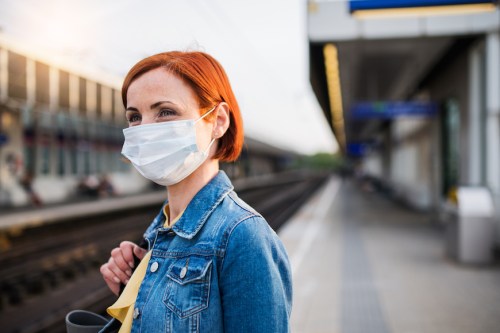Ready or not, pandemic restrictions are lifting, and the notion of getting back to “normal” is tentatively on the horizon. While that development is a positive one, for many, it’s also one that stokes anxiety. While adopting a quarantine lifestyle in the first place took some serious adjusting, adjust is what we did. Given this, it makes sense if the thought of abandoning your quarantine cocoon is met with fear. The good news is there are ways to help you ease yourself back into those former ways, for instance by learning how to do exposure therapy.
Experts in This Article
psychotherapist and founder of Manhattan Wellness
Exposure therapy is a method to help you overcome fears by subjecting yourself to them. In the case of the pandemic, practicing exposure therapy doesn’t necessarily mean flinging your mask aside and making out with everyone in a three-mile radius. Rather, it’s to be approached methodically, with gentleness and common sense, especially because there’s still a deadly disease out there.
“There’s a big difference between discomfort and anxiety, so continue to notice the differences for yourself,” says therapist and Manhattan Wellness founder Jennifer Teplin, LCSW. “I see great value in pushing yourself a bit out of your comfort zone, but make sure you’re taking small steps to avoid putting yourself in a mentally unhealthy space. There’s no exact timeline or rulebook for returning back to your new normal socially, so listening to your gut is always going to be the best rule.”
The key to using exposure therapy effectively is to start small. Generally speaking, this can be achieved in one of two ways: “You can take a larger goal and break it down into smaller action items or pick a bunch of small items that are close to or similar to the larger goal,” Teplin says. But how, exactly, do you implement these steps?
Below, get 4 tips for how to do exposure therapy to ease into post-pandemic life.
1. Identify what you miss, what you “must” return to, and what you’re fine to skip out on
Before you actually get out there, take a look at what aspects of your “real life” need a reprisal. If your job requires you to come back to the office a few days a week, for instance, that might be the first thing to work on. And if you’ve isolated for over a year but miss your friends, maybe it’s time to RSVP to a get-together in the park. But if you no longer want to toss back a bunch of drinks at a bar, allow yourself to sit that out.
“There are so many hurdles we have to overcome when returning to whatever you define as ‘normal life’, and there are also aspects of ‘normal life’ that you may want to leave in 2020. That’s absolutely okay,” says Teplin.
2. Ease into the routines you either “must” return to or miss most
Using the above example, let’s say your office is open now, but you’ll be formally required to come in three days a week in July. If you feel out of sync with the idea of your commute—whether you travel by foot, car, public transit, or otherwise—now is the time to start easing yourself in. Especially before others start doing the same, making things feel much more congested.
“If going to work feels stressful, begin with practicing your commute…Get your sea legs back before doing a deep dive.” —Jennifer Teplin, LCSW
“If going to work feels stressful, I’d begin with practicing your commute, or going in one day a week—if permitted and safe—ahead of going back the first day it’s required,” Teplin says. “Get your sea legs back before doing a deep dive.”
If there’s nothing that you really “must” return to, move on to the things you miss most about your past life. One of my go-to self-care practices pre-pandemic, for instance, was to go thrift-shopping after work; I haven’t been since March 2020, when my favorite store temporarily closed. But after I get my second vaccination, I suspect I’ll be returning for a bi-weekly trips to help me feel like I’m back in alignment.
3. Keep your headcount small for now
You may miss social gatherings, in theory, but crowds are a big stressor and source of fear when it comes to COVID-19. So, what do you do when a June wedding looks like it’s actually going to happen this time around the sun? Well, engage in smaller social meetups ahead of time, so you can feel better ready to handle your spot at Table 5.
“If you haven’t truly been social, don’t start your debut at a large gathering where you need to be your most outgoing self,” Teplin says. “Meet a friend or two for drinks or dinner or for a walk in the park to get things moving again.” But, if you feel anxious about the event itself that’s coming up and worry about whether or not it will be safe to attend, feel free to opt out of that, as well.
4. Don’t forget to speak how you’re feeling to others
Once you’re somewhere and starting to feel nervous, don’t feel like you have to hide away your fears. Naming your monster is a way to acknowledge it without giving it power. And more importantly, it can help you set boundaries while still connecting with others in a candid way.
“Often, once one person begins disclosing discomfort, others will follow,” says Teplin. And the effect can help you feel more supported and like a member of a likeminded community.
Oh hi! You look like someone who loves free workouts, discounts for cult-fave wellness brands, and exclusive Well+Good content. Sign up for Well+, our online community of wellness insiders, and unlock your rewards instantly.
Sign Up for Our Daily Newsletter
Get all the latest in wellness, trends, food, fitness, beauty, and more delivered right to your inbox.
Got it, you've been added to our email list.











